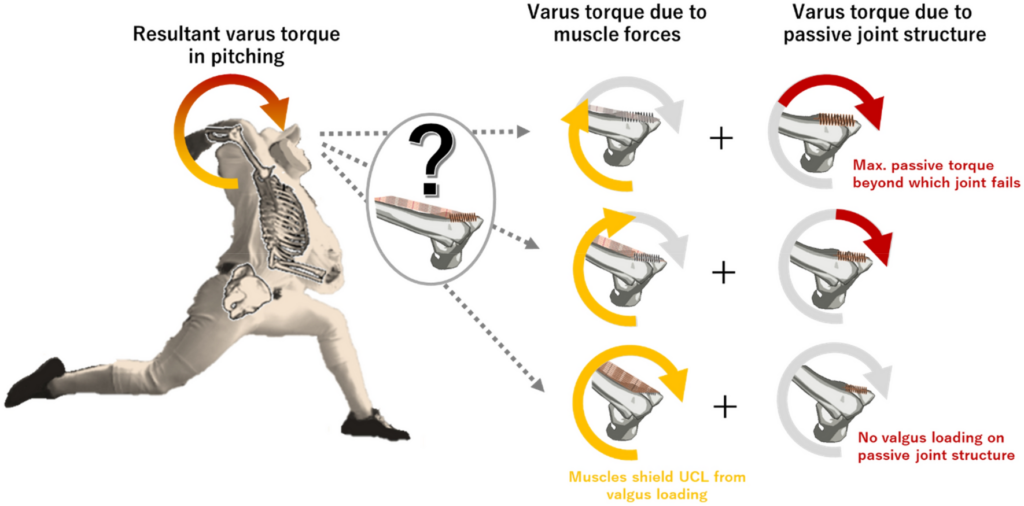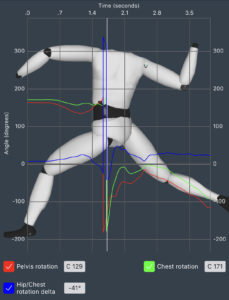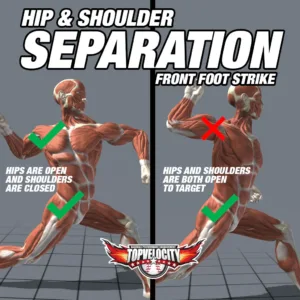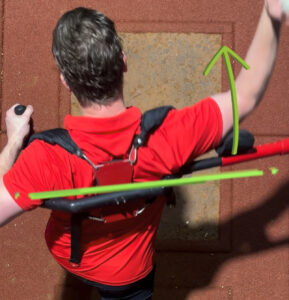The Trunk Excelerator is an innovative device designed to transform the way pitchers train and Reduce Pitching Elbow Stress. Developed with a deep understanding of the biomechanical demands of pitching, this tool focuses on reducing elbow stress—a common concern among pitchers at all levels of the sport. By guiding pitchers to engage their trunk more effectively during the pitching motion, the Trunk Excelerator promotes a healthier arm path that aligns with the natural movements of the body, thereby minimizing the risk of injury.
The primary purpose of the Trunk Excelerator is to prevent the high-risk arm movements that often lead to acute and chronic elbow injuries. This device uses a specialized mechanism to restrict certain harmful movements while promoting optimal trunk and arm alignment. This helps pitchers maintain a mechanically sound arm path throughout their pitching motion. The Trunk Excelerator is not just a protective tool; it also serves as a training device that reinforces the proper kinetic chain needed in pitching—from the legs, through the trunk, and ultimately to the arm.
Elbow health is paramount in pitching due to the extreme stresses placed on the joint during the pitching process. Each pitch can exert tremendous forces on the elbow, often leading to overuse injuries such as UCL tears or tendonitis if not properly managed. Maintaining elbow health is crucial not only for sustaining a long and successful career in baseball but also for ensuring that pitchers can perform at their peak without the looming threat of injury. The Trunk Excelerator is crafted to address these issues directly, offering a proactive approach to maintaining elbow health by optimizing the way pitchers use their bodies to generate power and control.
Understanding How to Reduce Pitching Elbow Stress

Elbow stress in pitching is a critical issue due to the unique and intense demands the sport places on a pitcher's arm. Understanding this stress is essential for developing effective training and prevention strategies. Each pitch, while a remarkable display of coordinated athleticism, involves a sequence of high-speed arm movements that place significant strain on the elbow joint. This stress can accumulate over time, leading to a range of injuries if not managed properly.
Common Causes of Elbow Stress in Pitchers
The primary cause of elbow stress in pitchers stems from the repetitive throwing motions required by the sport. These motions include:
- Overuse: Repeated throwing can lead to microscopic tears in the ligaments and tendons around the elbow, which, without adequate rest and recovery, can develop into more serious injuries.
- Poor Mechanics: Incorrect pitching mechanics can increase the load on the elbow. For instance, throwing with an over-the-top arm action or releasing the ball too late can significantly amplify stress on the elbow joint.
- High Velocity Throws: The sheer speed of pitches also contributes to elbow stress. The faster a pitcher throws, the greater the force exerted on the elbow during the deceleration phase of the pitch.
- Inadequate Physical Conditioning: Lack of strength in the muscles surrounding the elbow and shoulder can lead to improper load distribution during the pitching motion, placing additional stress on the elbow.
Explanation of Arm Path Dynamics: Reduce Pitching Elbow Stress
Arm path dynamics refer to the trajectory and motion of the arm during a pitch. A proper arm path is crucial for reducing stress on the elbow and enhancing overall pitching performance. The arm path should be smooth and natural, allowing for efficient energy transfer from the body to the ball. Key aspects include:
- Alignment: The elbow should align with the shoulder and the wrist throughout the pitching motion to ensure that forces are evenly distributed across the arm.
- Timing: The arm should move in sync with the rest of the body, especially the trunk. A delayed or accelerated arm motion relative to body rotation can result in increased elbow stress.
- Efficiency: An efficient arm path avoids unnecessary movements that can increase the strain on the elbow. This includes avoiding dropping the arm too low or rotating it excessively, which can lead to overloading of the elbow structures.
Understanding and optimizing these arm path dynamics with tools like the Trunk Excelerator can significantly reduce the risk of injury and improve a pitcher's longevity and performance in the sport.
The Role of the Trunk in Pitching Mechanics: Reduce Pitching Elbow Stress
 The trunk, or torso, plays a pivotal role in the mechanics of pitching, acting as the central link that transfers power from the lower body to the arm. Effective use of the trunk in pitching not only maximizes power and velocity but also helps in reducing the stress placed on the arm, particularly the elbow. Proper trunk rotation is crucial for achieving optimal biomechanical efficiency in the pitching motion.
The trunk, or torso, plays a pivotal role in the mechanics of pitching, acting as the central link that transfers power from the lower body to the arm. Effective use of the trunk in pitching not only maximizes power and velocity but also helps in reducing the stress placed on the arm, particularly the elbow. Proper trunk rotation is crucial for achieving optimal biomechanical efficiency in the pitching motion.
How the Trunk Influences Arm Movement
The trunk influences arm movement primarily through its rotational actions. As a pitcher initiates their motion towards the plate, the trunk rotates to align the shoulders perpendicular to the target, setting up a powerful throwing motion. This rotation is critical because it:
- Generates Momentum: As the trunk rotates, it creates kinetic energy that is transferred through the shoulder and down the arm, contributing to the velocity of the pitch.
- Aligns the Shoulder and Arm: Proper trunk rotation helps align the shoulder in the optimal position to facilitate a healthy and effective arm path, reducing undue stress on the elbow.
- Enhances Timing and Coordination: The synchronized movement of the trunk with the rest of the body ensures that the arm is not left to generate power on its own, which can be detrimental to the elbow.
Consequences of Poor Trunk Rotation: Reduce Pitching Elbow Stress
 Poor trunk rotation can have several detrimental effects on a pitcher’s mechanics and overall health:
Poor trunk rotation can have several detrimental effects on a pitcher’s mechanics and overall health:
- Increased Elbow and Shoulder Stress: Without adequate trunk rotation, the arm has to compensate by generating additional force, which can lead to increased stress on the elbow and shoulder joints, potentially resulting in injuries like UCL tears or shoulder impingements.
- Reduced Pitching Effectiveness: Inadequate trunk rotation can lead to a decrease in pitch velocity and accuracy. The lack of proper alignment and energy transfer diminishes the overall effectiveness of each pitch.
- Compromised Power Output: The power generated from the lower body may not be fully utilized if the trunk does not rotate correctly. This inefficiency can lead to a noticeable drop in the speed and force of the pitch, as the kinetic chain is disrupted.
- Altered Mechanics: Over time, poor trunk rotation can lead to alterations in pitching mechanics as the body attempts to compensate for the lack of trunk movement. These changes can ingrain bad habits that are difficult to correct and may increase the risk of chronic injuries.
Improving trunk rotation is not only about enhancing performance but also about safeguarding the pitcher's health, making it a crucial aspect of pitching mechanics that should be continuously developed and monitored.
Design Features of the Trunk Excelerator: Reduce Pitching Elbow Stress
 The Trunk Excelerator is specifically engineered with features that address the unique biomechanical needs of pitchers. Its innovative design focuses on improving pitching mechanics while simultaneously reducing the risk of injuries. Central to its effectiveness is the holster mechanism, which plays a pivotal role in maintaining proper arm and trunk alignment during the pitching process.
The Trunk Excelerator is specifically engineered with features that address the unique biomechanical needs of pitchers. Its innovative design focuses on improving pitching mechanics while simultaneously reducing the risk of injuries. Central to its effectiveness is the holster mechanism, which plays a pivotal role in maintaining proper arm and trunk alignment during the pitching process.
Holster Mechanism and Its Benefits
The holster mechanism of the Trunk Excelerator is a standout feature that distinguishes it from other training aids. It is designed to:
- Restrict Harmful Movements: By securing the arm in a specific position, the holster prevents movements that can lead to stress and injury, such as excessive elbow extension or improper arm lag.
- Promote Optimal Arm Path: The mechanism guides the pitcher’s arm through an ideal motion path, encouraging movements that are mechanically sound and efficient. This helps in developing muscle memory for correct pitching techniques.
- Enhance Kinetic Chain Efficiency: By ensuring that the arm moves in harmony with the trunk’s rotation, the holster helps in utilizing the kinetic energy generated from the lower body more effectively, leading to increased pitch velocity and reduced stress on the arm.
- Immediate Feedback for Correction: The physical constraints imposed by the holster provide immediate tactile feedback to the pitcher, helping them to adjust their mechanics in real-time during practice sessions.
How the Design Aligns the Elbow and Shoulder

Alignment of the elbow and shoulder is critical for efficient pitching mechanics and injury prevention. The design of the Trunk Excelerator specifically targets this alignment by:
- Maintaining Joint Synchronization: The device ensures that the elbow and shoulder move in a coordinated manner. This synchronization prevents the elbow from moving ahead or lagging behind the shoulder during the pitching motion, which is a common cause of stress injuries.
- Stabilizing Shoulder Position: The holster supports the shoulder in a position that optimizes power and reduces the risk of shoulder injuries. This stable positioning helps in maintaining a consistent arm slot, which is vital for pitch accuracy and effectiveness.
- Encouraging Proper Scapular Movement: Proper movement and positioning of the scapula (shoulder blade) are essential for a healthy pitching motion. The Trunk Excelerator’s design helps in promoting correct scapular rotation, which enhances shoulder stability and function during the pitch.
- Reducing Undue Stress on the Elbow: By aligning the elbow directly under the shoulder throughout the pitching motion, the device minimizes the lateral and rotational forces that typically act on the elbow, thus reducing the risk of injuries like UCL tears.
Overall, the Trunk Excelerator’s design not only aids in improving a pitcher's mechanics through better alignment and movement efficiency but also offers substantial protective benefits that can extend a pitcher's career and enhance performance consistency.
Preventing the Dragging Arm Path: Reduce Pitching Elbow Stress
 The "dragging arm path" refers to a common mechanical flaw in pitching where the pitcher's arm lags significantly behind the body during the delivery. This can put undue stress on the arm and lead to various performance and health issues. Addressing this issue is critical for both the effectiveness and longevity of a pitcher.
The "dragging arm path" refers to a common mechanical flaw in pitching where the pitcher's arm lags significantly behind the body during the delivery. This can put undue stress on the arm and lead to various performance and health issues. Addressing this issue is critical for both the effectiveness and longevity of a pitcher.
Why the Dragging Arm Path is Detrimental: Reduce Pitching Elbow Stress
The dragging arm path can lead to several significant problems for pitchers:
- Increased Stress on the Elbow and Shoulder: When the arm drags, it places additional stress on the elbow and shoulder as these joints attempt to catch up and accelerate rapidly to release the ball. This abrupt force can lead to injuries such as UCL tears or shoulder impingements.
- Compromised Pitch Velocity and Accuracy: A dragging arm often results in a reduction of pitch velocity because it disrupts the kinetic chain. The misalignment and timing issues it creates can also negatively affect the accuracy of pitches, making it difficult for pitchers to hit their targets.
- Altered Pitch Mechanics: Continual dragging can lead to alterations in a pitcher's overall mechanics, ingraining poor habits that are challenging to correct. These altered mechanics can diminish a pitcher's effectiveness and increase the risk of chronic injuries.
How the Trunk Excelerator Restricts This Movement: Reduce Pitching Elbow Stress
The Trunk Excelerator is specifically designed to combat the issue of the dragging arm path through several innovative features:
- Holster Mechanism: The Excelerator’s holster mechanism secures the arm in alignment with the trunk's rotational movement. This physical guide helps ensure that the arm does not lag behind during the pitch but moves in concert with the body, maintaining a synchronized and efficient motion.
- Promotion of Proper Timing: By guiding the arm and trunk to move together, the Excelerator helps establish the correct timing in the pitching sequence. This synchronicity helps to eliminate the delay that typically leads to a dragging arm, ensuring that the entire body works as a cohesive unit.
- Reinforcement of Efficient Kinetics: The device’s design encourages a smoother kinetic flow from the legs, through the trunk, and into the arm. This efficiency in energy transfer helps to naturally speed up the arm without the need for it to lag and then suddenly accelerate, thus reducing the likelihood of the dragging arm path.
- Immediate Feedback: The Trunk Excelerator provides tactile feedback, which is crucial for learning and correcting pitching mechanics in real-time. This feedback helps pitchers feel the correct arm path and adjust their movements instantly during training sessions, promoting muscle memory of the proper technique.
By addressing the dragging arm path, the Trunk Excelerator not only enhances a pitcher's performance but also significantly decreases the risk of injury, making it a valuable tool for pitchers aiming to sustain a healthy and successful career in baseball.
Avoiding Elbow Forward Thrust: Reduce Pitching Elbow Stress
Elbow forward thrust, or the action of pushing the elbow ahead of the lead shoulder during the pitching motion, is a common mechanical error among pitchers. This motion can lead to significant strain on the arm and shoulder, potentially causing a range of injuries and affecting pitch effectiveness.
Dangers of Pushing the Elbow Forward: Reduce Pitching Elbow Stress
 Pushing the elbow forward during pitching can have several negative consequences:
Pushing the elbow forward during pitching can have several negative consequences:
- Increased Risk of Elbow Injuries: When the elbow thrusts forward, it places excessive stress on the elbow joint and the surrounding ligaments, particularly the ulnar collateral ligament (UCL). This can lead to strains, tears, or even more severe conditions like elbow fractures.
- Shoulder Impingements and Injuries: Forward elbow movement can also affect the shoulder. It changes the normal kinematics of the shoulder joint, increasing the risk of impingements and rotator cuff injuries, as the unnatural angle strains the muscles and tendons.
- Reduced Pitching Efficiency: From a performance standpoint, pushing the elbow forward disrupts the kinetic chain and energy flow through the body to the ball. This often results in reduced velocity and less effective pitches because the energy transfer is not as fluid or powerful.
- Compromised Pitch Control: Accuracy and control are also compromised when the elbow moves ahead prematurely. The pitcher may struggle to consistently deliver pitches within the strike zone, affecting their overall effectiveness on the mound.
Mechanism of the Trunk Excelerator to Prevent This
The Trunk Excelerator is ingeniously designed to mitigate the risk of the elbow thrusting forward. Here’s how it accomplishes this:
- Holster Mechanism: The key feature of the Trunk Excelerator is its holster mechanism that securely holds the elbow in place relative to the shoulder. This prevents the elbow from moving forward independently of the trunk, ensuring that the elbow, shoulder, and trunk move as a cohesive unit.
- Promotes Proper Arm Alignment: By keeping the elbow tucked and aligned under the shoulder, the Excelerator helps maintain the natural anatomical position of the arm throughout the pitching motion. This alignment is crucial for preventing injuries and enhancing the mechanical efficiency of the pitch.
- Encourages Effective Trunk Engagement: The device also aids in better trunk rotation, which is essential for a powerful and safe pitching motion. Effective trunk engagement ensures that the energy from the lower body is transferred smoothly through the trunk to the arm, reducing the need for the arm to generate force independently.
- Real-time Feedback for Corrective Adjustment: With the Trunk Excelerator, pitchers receive immediate feedback on their arm position. If a pitcher begins to push their elbow forward, the restraint provided by the holster offers a physical reminder to adjust their motion, which is invaluable during practice for correcting and refining technique.
In essence, the Trunk Excelerator not only prevents the detrimental elbow forward thrust but also enhances overall pitching mechanics, leading to improved performance and reduced injury risk. This makes it an indispensable tool for pitchers at all levels who are serious about optimizing their technique and safeguarding their arms.
Reducing the Risk of Ulnar Collateral Ligament (UCL) Injuries
 The Ulnar Collateral Ligament (UCL) is a critical component of the elbow joint, particularly for pitchers, due to its central role in stabilizing the elbow during the high stresses of throwing. Injuries to the UCL can be career-threatening, making prevention a key focus for athletes and coaches alike.
The Ulnar Collateral Ligament (UCL) is a critical component of the elbow joint, particularly for pitchers, due to its central role in stabilizing the elbow during the high stresses of throwing. Injuries to the UCL can be career-threatening, making prevention a key focus for athletes and coaches alike.
Understanding UCL and Its Vulnerabilities
The UCL is located on the medial (inner) side of the elbow and connects the humerus (upper arm bone) to the ulna (one of the forearm bones). It is crucial for maintaining elbow stability, especially during the late cocking and acceleration phases of the pitching motion when the elbow experiences extreme torque and valgus stress (stress occurring when the forearm is forced outward away from the upper arm).
How the Trunk Excelerator Reduces Risks
The Trunk Excelerator is specifically designed to mitigate these vulnerabilities and reduce the risk of UCL injuries through several mechanisms:
- Optimized Arm Alignment: By ensuring that the arm does not drift away from the body or lead with the elbow, the Trunk Excelerator maintains optimal alignment. This alignment reduces the valgus stress on the elbow, thus protecting the UCL from excessive strain.
- Enhanced Trunk Coordination: The device promotes better coordination of trunk rotation with arm action. This synchronization ensures that the arm is not left to handle excessive loads alone, thereby distributing the forces more evenly and reducing the burden on the UCL.
- Restricted Harmful Movements: The Excelerator's holster mechanism prevents extreme ranges of motion that could potentially harm the UCL, such as excessive hyperextension or lateral movement of the elbow. This controlled range helps maintain the integrity of the elbow throughout the pitch.
- Training Proper Mechanics: Consistent use of the Trunk Excelerator trains pitchers to utilize their entire body more effectively when pitching. By developing mechanics that reduce reliance on the elbow to generate force and speed, the risk of UCL injuries is substantially lowered.
- Immediate Feedback for Technique Adjustment: The device provides physical feedback that helps pitchers feel and correct their mechanics in real-time. This feedback is crucial for making adjustments that protect the UCL during the learning and refinement of pitching techniques.
Through these features, the Trunk Excelerator serves as a valuable tool in the arsenal of preventive strategies against UCL injuries. It helps pitchers not only enhance their performance but also significantly lowers their risk of one of the most dreaded injuries in baseball.
Optimizing Trunk Rotation to Avoid Fly-Outs: Reduce Pitching Elbow Stress
 Trunk rotation is a critical component of the pitching motion, serving as the central mechanism through which power is transferred from the lower body to the arm. However, when not executed properly, it can lead to inefficiencies and potential injuries, including the problem of "fly-outs"—a term used to describe pitches that miss their intended location due to mechanical flaws.
Trunk rotation is a critical component of the pitching motion, serving as the central mechanism through which power is transferred from the lower body to the arm. However, when not executed properly, it can lead to inefficiencies and potential injuries, including the problem of "fly-outs"—a term used to describe pitches that miss their intended location due to mechanical flaws.
The Issue with Over-Rotation of the Trunk
Over-rotation of the trunk occurs when the pitcher's torso turns excessively before the arm action completes its motion. This can have several adverse effects:
- Decreased Accuracy and Control: Excessive trunk rotation can lead the arm away from its optimal path, resulting in pitches that are off-target. The timing of the pitch is disrupted, making it difficult for pitchers to control where the ball goes.
- Increased Stress on the Arm: When the trunk rotates too far, the arm has to compensate by making rapid, forceful adjustments to try and bring the ball to the target. This can place undue stress on the shoulder and elbow, heightening the risk of injury.
- Reduced Velocity: While it might seem counterintuitive, over-rotating can actually decrease the velocity of the pitch. This is because the energy generated by the lower body is not efficiently transferred through a properly aligned kinetic chain, causing power leaks.
 How Controlled Trunk Movement is Encouraged
How Controlled Trunk Movement is Encouraged
The Trunk Excelerator is specifically designed to foster controlled trunk movement, addressing the issues caused by over-rotation:
- Restrictive Mechanism: The device includes mechanisms that limit the range of trunk rotation to within optimal levels. This not only prevents over-rotation but also helps in maintaining the trunk's alignment with the lower body and shoulders, ensuring that the energy from the legs and hips is efficiently translated into the pitch.
- Promotion of Proper Timing: Controlled trunk movement is crucial for timing in the pitching motion. The Trunk Excelerator helps pitchers develop a sense of when to start and stop rotating the trunk, which is vital for synchronizing the lower body and arm action. This synchronization is key to maintaining pitch accuracy and maximizing velocity.
- Enhanced Muscle Memory: Regular use of the Trunk Excelerator trains the body to remember the feel of correct trunk rotation. This muscle memory is crucial for pitchers to develop consistent mechanics that can be reproduced during high-pressure situations in games.
- Immediate Feedback: The device provides immediate feedback if the trunk moves beyond a set rotational limit. This feedback is essential for making quick adjustments and helps pitchers internalize the correct movement patterns during their training sessions.
By optimizing trunk rotation, the Trunk Excelerator not only improves the accuracy and velocity of pitches but also significantly reduces the risk of injuries caused by mechanical inefficiencies. This makes it an invaluable tool for pitchers aiming to enhance their performance and protect their careers.
Delaying Trunk Rotation for Better Pitch Control
In pitching, the timing of trunk rotation is crucial for maximizing performance and accuracy. Delaying trunk rotation until the appropriate phase of the pitching motion can significantly enhance a pitcher's control over their pitches. This strategy involves maintaining the alignment and position of the trunk longer than usual, which has proven to be effective in refining pitch control.
Techniques to Delay Trunk Rotation
Several techniques can be employed to effectively delay trunk rotation, each contributing to a more controlled and powerful pitch delivery:
- Maintain Closed Shoulder Position: One of the key methods to delay trunk rotation is by keeping the shoulders closed towards the catcher for as long as possible. This means the pitcher's front shoulder should remain pointed towards home plate, delaying the opening of the shoulder until the lead leg starts its descent in the pitching motion.
- Enhanced Lower Body Strength and Stability: Stronger legs and core allow pitchers to maintain stability and control for longer before initiating trunk rotation. Exercises that strengthen the core, hips, and legs can help pitchers maintain this delayed rotation.
- Focus on Lower Body Mechanics: By emphasizing the role of the lower body in generating force and initiating movement towards home plate, pitchers can reduce the early engagement of the upper body. This focus helps in conserving the upper body's movement until the critical moment, thus delaying trunk rotation.
- Use of Drills and Tools: Specific drills that focus on segmenting the pitching motion can help in practicing delayed trunk rotation. Tools like the Trunk Excelerator aid in physically reinforcing this technique by restricting premature movement and providing feedback on timing.
Benefits of Delayed Rotation in Pitch Accuracy
Delaying trunk rotation offers several benefits, particularly in terms of pitch accuracy:
- Increased Energy Transfer: By delaying the trunk's rotation, pitchers can build up more kinetic energy in the lower body, which is then transferred more efficiently when the trunk finally rotates. This efficient energy transfer can lead to increased pitch velocity as well as improved accuracy.
- Improved Timing and Coordination: Delayed rotation helps in synchronizing the movements of the legs, hips, and arms, which is crucial for timing the release of the pitch perfectly. Better coordination ensures that the ball is released consistently at the optimum point, enhancing accuracy.
- Reduction in Mechanical Errors: When the trunk rotates too early, it can lead to several mechanical errors, such as opening up the shoulder prematurely or misaligning the arm path. By delaying rotation, these errors are minimized, leading to more consistent pitches.
- Enhanced Pitch Deception: For pitchers, especially those who rely on deception, delaying trunk rotation can make it harder for hitters to predict the pitch type or location. This tactical advantage can be crucial in competitive settings.
Incorporating delayed trunk rotation into a pitcher's technique not only improves pitch control and accuracy but also contributes to overall mechanical efficiency and effectiveness on the mound. By focusing on these techniques and understanding the benefits, pitchers can significantly enhance their game performance.
Command and Velocity Improvement Techniques
Improving command and velocity are pivotal for pitchers aiming to elevate their game. Techniques that enhance these aspects of pitching not only make a pitcher more effective but also more intimidating to batters. The Trunk Excelerator, a specialized training device, plays a significant role in assisting pitchers to enhance both their command and velocity through biomechanical efficiency and targeted training practices.
How the Trunk Excelerator Improves Pitching Command
Pitching command refers to a pitcher's ability to control where they throw the ball, specifically in terms of hitting intended strike zones. Here's how the Trunk Excelerator enhances this ability:
- Improved Mechanical Consistency: The device ensures consistent mechanics by aligning the trunk and arm properly during the pitching motion. This consistency is key to repeatable pitches, which is fundamental to good command. When a pitcher can reliably repeat their motion, their accuracy naturally improves.
- Enhanced Focus on Body Mechanics: By using the Trunk Excelerator, pitchers can focus more on their body's mechanics rather than solely on the ball's destination. This mindfulness allows for better control over the pitch, as minor adjustments in body positioning can be made to correct trajectories.
- Restriction of Unnecessary Movements: The device restricts movements that could lead to inaccuracies, such as excessive trunk rotation or misalignment of the arm. By limiting these movements, pitchers can maintain a cleaner, more efficient pitching path, which directly improves command.
Impact on Pitch Velocity
Velocity is critical in pitching, as faster pitches are generally more difficult for batters to hit. The Trunk Excelerator contributes to increased pitch velocity through the following mechanisms:
- Optimized Energy Transfer: By ensuring that the trunk and arm move in harmony, the Trunk Excelerator helps maintain an optimal kinetic chain. This harmony allows energy generated from the lower body to transfer more effectively through the trunk and into the arm, resulting in faster pitches.
- Reduced Energy Leakage: The device minimizes energy leakage by preventing misalignments and inefficient body movements during the pitch. When energy is conserved rather than lost in unnecessary movements, it contributes directly to increased velocity.
- Training Muscle Memory: Regular use of the Trunk Excelerator trains the pitcher’s muscles to move in the most efficient manner possible. Over time, this muscle memory leads to quicker, sharper movements that naturally enhance pitch speed.
- Increased Stability and Control: The stability provided by the device during the pitching motion allows pitchers to exert maximum force at the point of release without the risk of losing balance or control. This ability to apply force confidently and safely is crucial for achieving high velocity.
In conclusion, the Trunk Excelerator is an invaluable tool for pitchers looking to enhance both their command and velocity. Through mechanical guidance, energy optimization, and the training of proper motion paths, the device not only boosts performance but also contributes to the overall development of the pitcher’s skills. This combination of improved command and increased velocity equips pitchers to succeed at higher levels of competition, making the Trunk Excelerator a key component in the arsenal of modern pitching training methods.
Where to Purchase the Trunk Excelerator
 For pitchers eager to take their skills to the next level, the Trunk Excelerator is available for purchase. This innovative device has been designed to help pitchers improve their mechanics, enhance velocity, and gain better control over their pitches, all while reducing the risk of injury. Whether you're a budding amateur or an experienced professional, the Trunk Excelerator is an essential tool in your training regimen.
For pitchers eager to take their skills to the next level, the Trunk Excelerator is available for purchase. This innovative device has been designed to help pitchers improve their mechanics, enhance velocity, and gain better control over their pitches, all while reducing the risk of injury. Whether you're a budding amateur or an experienced professional, the Trunk Excelerator is an essential tool in your training regimen.
To get your own Trunk Excelerator, visit TopVelocity.net. Here, you can learn more about how the Trunk Excelerator works, read testimonials from users, and see the results it has helped others achieve. Don't miss the opportunity to transform your pitching performance. Visit the website today and take the first step towards unleashing your full potential on the mound!


 How Controlled Trunk Movement is Encouraged
How Controlled Trunk Movement is Encouraged

